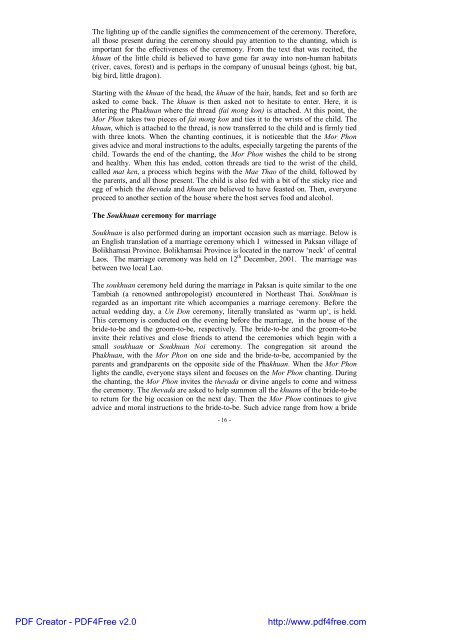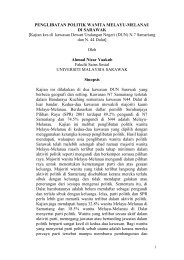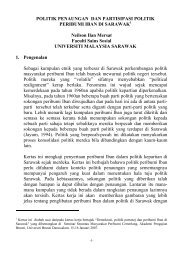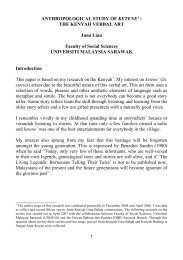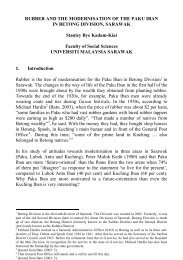OF SOUKHUAN AND LAOS Elena Gregoria Chai Chin Fern Faculty ...
OF SOUKHUAN AND LAOS Elena Gregoria Chai Chin Fern Faculty ...
OF SOUKHUAN AND LAOS Elena Gregoria Chai Chin Fern Faculty ...
You also want an ePaper? Increase the reach of your titles
YUMPU automatically turns print PDFs into web optimized ePapers that Google loves.
The lighting up of the candle signifies the commencement of the ceremony. Therefore,<br />
all those present during the ceremony should pay attention to the chanting, which is<br />
important for the effectiveness of the ceremony. From the text that was recited, the<br />
khuan of the little child is believed to have gone far away into non-human habitats<br />
(river, caves, forest) and is perhaps in the company of unusual beings (ghost, big bat,<br />
big bird, little dragon).<br />
Starting with the khuan of the head, the khuan of the hair, hands, feet and so forth are<br />
asked to come back. The khuan is then asked not to hesitate to enter. Here, it is<br />
entering the Phakhuan where the thread (fai mong kon) is attached. At this point, the<br />
Mor Phon takes two pieces of fai mong kon and ties it to the wrists of the child. The<br />
khuan, which is attached to the thread, is now transferred to the child and is firmly tied<br />
with three knots. When the chanting continues, it is noticeable that the Mor Phon<br />
gives advice and moral instructions to the adults, especially targeting the parents of the<br />
child. Towards the end of the chanting, the Mor Phon wishes the child to be strong<br />
and healthy. When this has ended, cotton threads are tied to the wrist of the child,<br />
called mat ken, a process which begins with the Mae Thao of the child, followed by<br />
the parents, and all those present. The child is also fed with a bit of the sticky rice and<br />
egg of which the thevada and khuan are believed to have feasted on. Then, everyone<br />
proceed to another section of the house where the host serves food and alcohol.<br />
The Soukhuan ceremony for marriage<br />
Soukhuan is also performed during an important occasion such as marriage. Below is<br />
an English translation of a marriage ceremony which I witnessed in Paksan village of<br />
Bolikhamsai Province. Bolikhamsai Province is located in the narrow ‘neck’ of central<br />
Laos. The marriage ceremony was held on 12 th December, 2001. The marriage was<br />
between two local Lao.<br />
The soukhuan ceremony held during the marriage in Paksan is quite similar to the one<br />
Tambiah (a renowned anthropologist) encountered in Northeast Thai. Soukhuan is<br />
regarded as an important rite which accompanies a marriage ceremony. Before the<br />
actual wedding day, a Un Don ceremony, literally translated as ‘warm up‘, is held.<br />
This ceremony is conducted on the evening before the marriage, in the house of the<br />
bride-to-be and the groom-to-be, respectively. The bride-to-be and the groom-to-be<br />
invite their relatives and close friends to attend the ceremonies which begin with a<br />
small soukhuan or Soukhuan Noi ceremony. The congregation sit around the<br />
Phakhuan, with the Mor Phon on one side and the bride-to-be, accompanied by the<br />
parents and grandparents on the opposite side of the Phakhuan. When the Mor Phon<br />
lights the candle, everyone stays silent and focuses on the Mor Phon chanting. During<br />
the chanting, the Mor Phon invites the thevada or divine angels to come and witness<br />
the ceremony. The thevada are asked to help summon all the khuans of the bride-to-be<br />
to return for the big occasion on the next day. Then the Mor Phon continues to give<br />
advice and moral instructions to the bride-to-be. Such advice range from how a bride<br />
- 16 -<br />
PDF Creator - PDF4Free v2.0<br />
http://www.pdf4free.com


